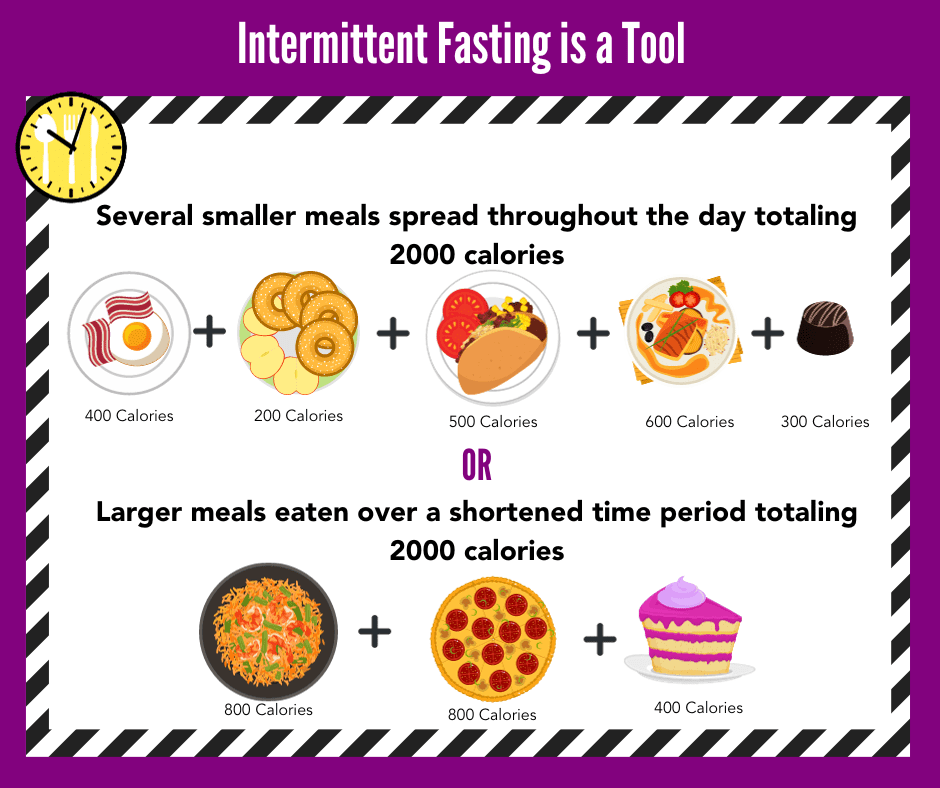Jump to a Topic
What is Intermittent Fasting?
Put simply, intermittent fasting refers to a method of eating that only allows you to eat during specific times of the day. The exact times do not necessarily matter, but rather that you can only eat during that specific period. For example, you may choose to only eat at breakfast time and skip lunch and dinner, or you may choose to skip breakfast and lunch and just eat dinner.
There are a lot of different ways you can practice intermittent fasting, but the core tenant is you restrict your “feeding window” to a short period of time. The most common way people do this is they only allow themselves 4 to 6 hours to eat during the day. These are often referred to as 20:4, 18:6 or 16/8 fasting. Furthermore, the most common way people practice this is that they usually skip breakfast, lunch or both and eat within an 8, 6 or 4 hour window.
This method is often used by people trying to lose weight, and it can be very effective for many people.
It is often thought that this approach to eating conveys some metabolic benefit and increases fat loss, but the truth is, the reason that intermittent fasting works is that it reduces the amount of time you can eat during the day.
This means less meals and less snacking, which often leads to consuming fewer calories during the day, whether the individual is hyper diligent about tracking or not.

What are the Best Macros for Intermittent Fasting?
When it comes to determining the best macronutrient ratio for intermittent fasting, it’s essential to recognize that there is no one-size-fits-all answer.
The ideal macro ratio can vary significantly from one individual to another based on factors such as age, gender, activity level, and specific health and fitness goals.
This personalized approach is what makes the combination of intermittent fasting and tracking macros so versatile and effective for a wide range of people.
To understand your macro needs, use a tool such as a macro calculator to determine exactly what you need for your goal.
How Do Intermittent Fasting and Tracking Macros Differ?
Intermittent fasting is simply a time-based framework. It tells you when you should eat, but it does not really provide any structure about what you should eat, how much you should eat, and what kind of nutrients you should include in your food. And that can often be the appeal of Intermittent fasting.
“Don’t worry about how many calories you eat or if you eat nutritious food. Just skip breakfast and lunch and house two whole pepperoni pizzas at dinner and you will be just fine”
Tracking your macros is different from intermittent fasting in a few key ways. The first is that tracking macros is not really a “diet system”, but rather just a way to quantify how much food you are eating.
Tracking your macros really just involves understanding your body’s calorie and nutrient needs and then tracking what you eat and trying to make sure what you eat is closely matching your body’s needs.
So, Should I Track my Macros and do IF?
If you are practicing intermittent fasting, you probably should track your macros for a while so you still have some understanding of how many calories you are consuming in a day.
Imagine how much more effective your intermittent fasting approach to eating might be if you know that during your feeding window that you were consuming the right number of calories to ensure that you are making progress to your goals.
I mean, if skipping breakfast and lunch and just eating dinner wasn’t helping you make progress, would you even want to do it?
Combining the skills and self-accountability of tracking your food while utilizing intermittent fasting is a great way to increase your likelihood of success when following an intermittent fasting approach.
Try our nutrition coaching, for free!
Be the next success story. Over 30,000 have trusted Macros Inc to transform their health.
Simply fill out the form below to start your 14-day risk-free journey. Let's achieve your goals together!

